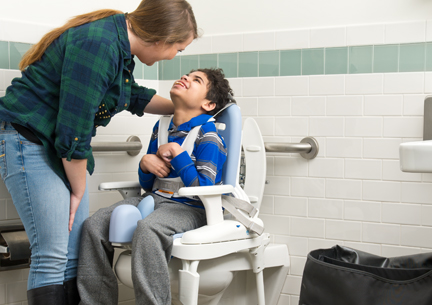Adaptive Toilet Transfers at a MOVE® Facility
Rifton Support Station Video 2
Staff at a MOVE® facility explain how the Rifton Support Station has transformed their toileting protocols by giving them a new way to perform dignified, safe toilet transfers in which the client can assist with their own personal care. The story of one of the clients, Francie, is particularly highlighted in this short video. A transcript is provided below for viewers with hearing disabilities.
Transcript
[00:00:01.00] Caption: A MOVE™ Success Story
[00:00:11.00] Narrator: MOVE™ is an approach to therapy for people with disabilities that emphasizes actively and continually developing mobility skills with the goal of improving overall quality of life.
[00:00:29.00] Narrator: The MOVE™ curriculum has been adopted by facilities across the nation, including Chesapeake Care Resources in Maryland. The Center was chosen by MOVE™ as a data collection site for a two-year, evidence-based research study. They measured progress gained by participants, in building their skills in toileting and mobility. They relied on the Support Station as an essential part of the toileting curriculum. The results at Chesapeake have been dramatic. This is what Day Program Director Cindi Spink has to say about their experiences with the Support Station.
[00:01:04.00] Cindi Spink, Director, Day Program: The greatest success story that we have seen is with Francie. Francie is an approximately 45 year-old woman who used to be able to walk and bear her own weight. But over the years, she really declined; lost a lot of her skills, and gained a tremendous amount of weight. She would need three to four people to transfer her onto the changing table to change her. She used to be toileted; she used to be able to get onto the toilet by herself. When we chose her to be part of the research study we really doubted how much progress we were going to be able to see with her, because there was such resistance. Little by little she started getting the feel of it; she started taking steps once again. She started being able to stand.
[00:01:51.00] Cindi Spink: When we started the toileting program, she was one of the first people we thought of, because she had that ability before, and we wanted to work with her to bring it back. When Rifton brought the Support Station we thought: "Ah, this is what we need." She was the first person that we tried with the Support Station.
[00:02:09.00] Cindi Spink: She's become so proficient at it and so confident of herself that she comes in the back door in the morning, in her wheelchair and wheels right up to the bathroom, pushes the doors open and wheels herself up to the Support Station. She will stand herself up,? she holds on to the prompts, and feels very secure standing there waiting for us to come to help her with her clothing. The look of success; the look of accomplishment on her face is just tremendous. It is such a tremendous change to see these individuals being able to do things for themselves.
[00:02:44.00] PT (to Francie): She's my baby. This girl has come such a long way.
[00:02:50.00] Narrator: You can learn more about MOVE™ at Move-International.org
[00:02:54.00] Narrator: Visit www.rifton.com/supportstation or call us any time to learn more about the advantages of the Support Station in facilities like yours.




